- Home
- Bill Bryson
A Short History of Nearly Everything: Special Illustrated Edition
A Short History of Nearly Everything: Special Illustrated Edition Read online
Copyright © 2003, 2005 by Bill Bryson
All rights reserved.
Published in the United States by Broadway Books, an imprint of the Crown Publishing Group, a division of Random House, Inc., New York.
www.crownpublishing.com
BROADWAY BOOKS and the Broadway Books colophon are trademarks of Random House, Inc.
This edition was originally published in hardcover in Great Britain by Transworld Publishers, London, and in the United States by Broadway Books, New York, in 2005. A previous unillustrated edition was first published in hardcover in Great Britain by Transworld Publishers, London, and in the United States by Broadway Books, New York, in 2003.
Cataloging-in-Publication Data is on file with the Library of Congress.
eISBN: 978-0-307-88516-6
v3.1
To Meghan and Chris. Welcome.
CONTENTS
Cover
Title Page
Copyright
Dedication
ACKNOWLEDGEMENTS
INTRODUCTION
ONE: LOST IN THE COSMOS
1 How to Build a Universe
2 Welcome to the Solar System
3 The Reverend Evans’s Universe
TWO: THE SIZE OF THE EARTH
4 The Measure of Things
5 The Stone-Breakers
6 Science Red in Tooth and Claw
7 Elemental Matters
THREE: A NEW AGE DAWNS
8 Einstein’s Universe
9 The Mighty Atom
10 Getting the Lead Out
11 Muster Mark’s Quarks
12 The Earth Moves
FOUR: DANGEROUS PLANET
13 Bang!
14 The Fire Below
15 Dangerous Beauty
FIVE: LIFE ITSELF
16 Lonely Planet
17 Into the Troposphere
18 The Bounding Main
19 The Rise of Life
20 Small World
21 Life Goes On
22 Goodbye to All That
23 The Richness of Being
24 Cells
25 Darwin’s Singular Notion
26 The Stuff of Life
SIX: THE ROAD TO US
27 Ice Time
28 The Mysterious Biped
29 The Restless Ape
30 Goodbye
NOTES
BIBLIOGRAPHY
ILLUSTRATIONS
INDEX
ACKNOWLEDGEMENTS
As I sit here, in early 2003, I have before me several pages of manuscript bearing majestically encouraging and tactful notes from Ian Tattersall of the American Museum of Natural History pointing out, inter alia, that Périgueux is not a wine-producing region, that it is inventive but a touch unorthodox of me to italicize taxonomic divisions above the level of genus and species, that I have persistently misspelled Olorgesailie (a place I visited only recently), and so on in similar vein through two chapters of text covering his area of expertise, early humans.
Goodness knows how many other inky embarrassments may lurk in these pages yet, but it is thanks to Dr. Tattersall and all of those whom I am about to mention that there aren’t many hundreds more. I cannot begin to thank adequately those who helped me in the preparation of this book. I am especially indebted to the following, who were uniformly generous and kindly and showed the most heroic reserves of patience in answering one simple, endlessly repeated question: “I’m sorry, but can you explain that again?”
In England: David Caplin of Imperial College London; Richard Fortey, Len Ellis and Kathy Way of the Natural History Museum; Martin Raff of University College London; Rosalind Harding of the Institute of Biological Anthropology in Oxford; Dr Laurence Smaje, formerly of the Wellcome Institute; and Keith Blackmore of The Times.
In the United States: Ian Tattersall of the American Museum of Natural History in New York; John Thorstensen, Mary K. Hudson and David Blanchflower of Dartmouth College in Hanover, New Hampshire; Dr. William Abdu and Dr. Bryan Marsh of Dartmouth–Hitchcock Medical Center in Lebanon, New Hampshire; Ray Anderson and Brian Witzke of the Iowa Department of Natural Resources, Iowa City; Mike Voorhies of the University of Nebraska and Ashfall Fossil Beds State Park near Orchard, Nebraska; Chuck Offenburger of Buena Vista University, Storm Lake, Iowa; Ken Rancourt, director of research, Mount Washington Observatory, Gorham, New Hampshire; Paul Doss, geologist of Yellowstone National Park, and his wife, Heidi, also of the National Park; Frank Asaro of the University of California at Berkeley; Oliver Payne and Lynn Addison of the National Geographic Society; James O. Farlow, Indiana-Purdue University; Roger L. Larson, professor of marine geophysics, University of Rhode Island; Jeff Guinn of the Fort Worth Star-Telegram newspaper; Jerry Kasten of Dallas, Texas; and the staff of the Iowa Historical Society in Des Moines.
In Australia: the Reverend Robert Evans of Hazelbrook, New South Wales; Dr. Jill Cainey, Australian Bureau of Meteorology; Alan Thorne and Victoria Bennett of the Australian National University in Canberra; Louise Burke and John Hawley of Canberra; Anne Milne of the Sydney Morning Herald; Ian Nowak, formerly of the Geological Society of Western Australia; Thomas H. Rich of Museum Victoria; Tim Flannery, director of the South Australian Museum in Adelaide; Natalie Papworth and Alan MacFadyen of the Royal Tasmanian Botanical Gardens, Hobart; and the very helpful staff of the State Library of New South Wales in Sydney.
And elsewhere: Sue Superville, information centre manager at the Museum of New Zealand in Wellington; and Dr. Emma Mbua, Dr. Koen Maes and Jillani Ngalla of the Kenya National Museum in Nairobi.
I am also deeply and variously indebted to Patrick Janson-Smith, Gerald Howard, Marianne Velmans, Alison Tulett, Gillian Somerscales, Larry Finlay, Steve Rubin, Jed Mattes, Carol Heaton, Charles Elliott, David Bryson, Felicity Bryson, Dan McLean, Nick Southern, Gerald Engelbretsen, Patrick Gallagher, Larry Ashmead, and the staff of the peerless and ever-cheery Howe Library in Hanover, New Hampshire.
Above all, and as always, my profoundest thanks to my dear, patient, incomparable wife, Cynthia.
2003
For their work in helping to produce this illustrated edition, my thanks go to Katrina Whone, Sheila Lee, Jo Micklem, Phil Lord, Alex Smith, Emma Smith, Alison Martin, Cordelia Molloy and Ruth McKernan.
Finally, I wish to thank and remember Miriam Hyman, who died in the terrorist attack on London on 7 July 2005, shortly after completing her work as a picture researcher on this edition.
2005
INTRODUCTION
Welcome. And congratulations. I am delighted that you could make it. Getting here wasn’t easy, I know. In fact, I suspect it was a little tougher than you realize.
To begin with, for you to be here now trillions of drifting atoms had somehow to assemble in an intricate and curiously obliging manner to create you. It’s an arrangement so specialized and particular that it has never been tried before and will only exist this once. For the next many years (we hope) these tiny particles will uncomplainingly engage in all the billions of deft, co-operative efforts necessary to keep you intact and let you experience the supremely agreeable but generally under-appreciated state known as existence.
Why atoms take this trouble is a bit of a puzzle. Being you is not a gratifying experience at the atomic level. For all their devoted attention, your atoms don’t actually care about you—indeed, don’t even know that you are there. They don’t even know that they are there. They are mindless particles, after all, and not even themselves alive. (It is a slightly arresting notion that if you were to pick yourself apart with tweezers, one atom at a time, you would pro
duce a mound of fine atomic dust, none of which had ever been alive but all of which had once been you.) Yet somehow for the period of your existence they will answer to a single rigid impulse: to keep you you.
The bad news is that atoms are fickle and their time of devotion is fleeting—fleeting indeed. Even a long human life adds up to only about 650,000 hours. And when that modest milestone flashes into view, or at some other point thereabouts, for reasons unknown your atoms will close you down, then silently disassemble and go off to be other things. And that’s it for you.
Still, you may rejoice that it happens at all. Generally speaking in the universe it doesn’t, so far as we can tell. This is decidedly odd because the atoms that so liberally and congenially flock together to form living things on Earth are exactly the same atoms that decline to do it elsewhere. Whatever else it may be, at the level of chemistry life is fantastically mundane: carbon, hydrogen, oxygen and nitrogen, a little calcium, a dash of sulphur, a light dusting of other very ordinary elements—nothing you wouldn’t find in any ordinary pharmacy—and that’s all you need. The only thing special about the atoms that make you is that they make you. That is, of course, the miracle of life.
Whether or not atoms make life in other corners of the universe, they make plenty else; indeed, they make everything else. Without them there would be no water or air or rocks, no stars and planets, no distant gassy clouds or swirling nebulae or any of the other things that make the universe so agreeably material. Atoms are so numerous and necessary that we easily overlook that they needn’t actually exist at all. There is no law that requires the universe to fill itself with small particles of matter or to produce light and gravity and the other properties on which our existence hinges. There needn’t actually be a universe at all. For a very long time there wasn’t. There were no atoms and no universe for them to float about in. There was nothing—nothing at all anywhere.
So thank goodness for atoms. But the fact that you have atoms and that they assemble in such a willing manner is only part of what got you here. To be here now, alive in the twenty-first century and smart enough to know it, you also had to be the beneficiary of an extraordinary string of biological good fortune. Survival on Earth is a surprisingly tricky business. Of the billions and billions of species of living things that have existed since the dawn of time, most—99.99 per cent, it has been suggested—are no longer around. Life on Earth, you see, is not only brief but dismayingly tenuous. It is a curious feature of our existence that we come from a planet that is very good at promoting life but even better at extinguishing it.
The average species on Earth lasts for only about four million years, so if you wish to be around for billions of years, you must be as fickle as the atoms that made you. You must be prepared to change everything about yourself—shape, size, colour, species affiliation, everything—and to do so repeatedly. That’s much easier said than done, because the process of change is random. To get from “protoplasmal primordial atomic globule” (as Gilbert and Sullivan put it) to sentient upright modern human has required you to mutate new traits over and over in a precisely timely manner for an exceedingly long while. So at various periods over the last 3.8 billion years you have abhorred oxygen and then doted on it, grown fins and limbs and jaunty sails, laid eggs, flicked the air with a forked tongue, been sleek, been furry, lived underground, lived in trees, been as big as a deer and as small as a mouse, and a million things more. The tiniest deviation from any of these evolutionary imperatives and you might now be licking algae from cave walls or lolling walrus-like on some stony shore or disgorging air through a blowhole in the top of your head before diving sixty feet for a mouthful of delicious sandworms.
Not only have you been lucky enough to be attached since time immemorial to a favoured evolutionary line, but you have also been extremely—make that miraculously—fortunate in your personal ancestry. Consider the fact that for 3.8 billion years, a period of time older than the Earth’s mountains and rivers and oceans, every one of your forebears on both sides has been attractive enough to find a mate, healthy enough to reproduce, and sufficiently blessed by fate and circumstances to live long enough to do so. Not one of your pertinent ancestors was squashed, devoured, drowned, starved, stuck fast, untimely wounded or otherwise deflected from its life’s quest of delivering a tiny charge of genetic material to the right partner at the right moment to perpetuate the only possible sequence of hereditary combinations that could result—eventually, astoundingly, and all too briefly—in you.
This is a book about how it happened—in particular, how we went from there being nothing at all to there being something, and then how a little of that something turned into us, and also some of what happened in between and since. That’s rather a lot to cover, of course, which is why the book is called A Short History of Nearly Everything, even though it isn’t really. It couldn’t be. But with luck by the time we finish it may feel as if it is.
My own starting point, for what it is worth, was a school science book that I had when I was in fourth or fifth grade. The book was a standard-issue 1950s schoolbook—battered, unloved, grimly hefty—but near the front it had an illustration that just captivated me: a cutaway diagram showing the Earth’s interior as it would look if you cut into the planet with a large knife and carefully withdrew a wedge representing about a quarter of its bulk.
It’s hard to believe that there was ever a time when I had not seen such an illustration before, but evidently I had not for I clearly remember being transfixed. I suspect, in honesty, my initial interest was based on a private image of streams of unsuspecting eastbound motorists in the American plains states plunging over the edge of a sudden four-thousand-mile-high cliff running between Central America and the North Pole, but gradually my attention did turn in a more scholarly manner to the scientific import of the drawing and the realization that the Earth consisted of discrete layers, ending in the centre with a glowing sphere of iron and nickel, which was as hot as the surface of the Sun, according to the caption, and I remember thinking with real wonder: “How do they know that?”
(credit i.1)
I didn’t doubt the correctness of the information for an instant—I still tend to trust the pronouncements of scientists in the way I trust those of surgeons, plumbers, and other possessors of arcane and privileged information—but I couldn’t for the life of me conceive how any human mind could work out what spaces thousands of miles below us, that no eye had ever seen and no X-ray could penetrate, could look like and be made of. To me that was just a miracle. That has been my position with science ever since.
Excited, I took the book home that night and opened it before dinner—an action that I expect prompted my mother to feel my forehead and ask if I was all right—and, starting with the first page, I read.
And here’s the thing. It wasn’t exciting at all. It wasn’t actually altogether comprehensible. Above all, it didn’t answer any of the questions that the illustration stirred up in a normal enquiring mind: How did we end up with a Sun in the middle of our planet and how do they know how hot it is? And if it is burning away down there, why isn’t the ground under our feet hot to the touch? And why isn’t the rest of the interior melting—or is it? And when the core at last burns itself out, will some of the Earth slump into the void, leaving a giant sinkhole on the surface? And how do you know this? How did you figure it out?
But the author was strangely silent on such details—indeed, silent on everything but anticlines, synclines, axial faults and the like. It was as if he wanted to keep the good stuff secret by making all of it soberly unfathomable. As the years passed, I began to suspect that this was not altogether a private impulse. There seemed to be a mystifying universal conspiracy among textbook authors to make certain the material they dealt with never strayed too near the realm of the mildly interesting and was always at least a long-distance phone call from the frankly interesting.
I now know that there is a happy abundance of science writers who pen the most
lucid and thrilling prose—Timothy Ferris, Richard Fortey and Tim Flannery are three that jump out from a single station of the alphabet (and that’s not even to mention the late but godlike Richard Feynman)—but, sadly, none of them wrote any textbook I ever used. All mine were written by men (it was always men) who held the interesting notion that everything became clear when expressed as a formula and the amusingly deluded belief that the children of America would appreciate having chapters end with a section of questions they could mull over in their own time. So I grew up convinced that science was supremely dull, but suspecting that it needn’t be, and not really thinking about it at all if I could help it. This, too, became my position for a long time.
Then, much later—about four or five years ago, I suppose—I was on a long flight across the Pacific, staring idly out the window at moonlit ocean, when it occurred to me with a certain uncomfortable forcefulness that I didn’t know the first thing about the only planet I was ever going to live on. I had no idea, for example, why the oceans were salty but the Great Lakes weren’t. Didn’t have the faintest idea. I didn’t know if the oceans were growing more salty with time or less, and whether ocean salinity levels were something I should be concerned about or not. (I am very pleased to tell you that until the late 1970s scientists didn’t know the answers to these questions either. They just didn’t talk about it very audibly.)
And ocean salinity, of course, represented only the merest sliver of my ignorance. I didn’t know what a proton was, or a protein, didn’t know a quark from a quasar, didn’t understand how geologists could look at a layer of rock on a canyon wall and tell you how old it was—didn’t know anything, really. I became gripped by a quiet, unwonted but insistent urge to know a little about these matters and to understand above all how people figured them out. That to me remained the greatest of all amazements—how scientists work things out. How does anybody know how much the Earth weighs or how old its rocks are or what really is way down there in the centre? How can they know how and when the universe started and what it was like when it did? How do they know what goes on inside an atom? And how, come to that—or perhaps above all, on reflection—can scientists so often seem to know nearly everything but then still not be able to predict an earthquake or even tell us whether we should take an umbrella with us to the races next Wednesday?

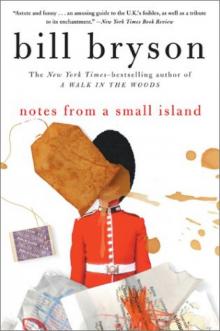 Notes from a Small Island
Notes from a Small Island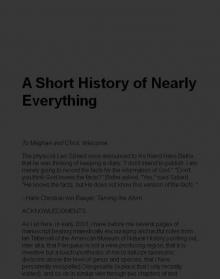 A Short History of Nearly Everything
A Short History of Nearly Everything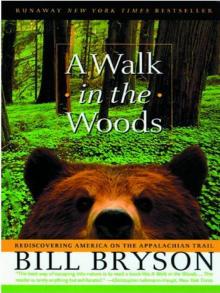 A Walk in the Woods
A Walk in the Woods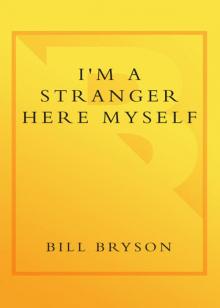 I'm a Stranger Here Myself
I'm a Stranger Here Myself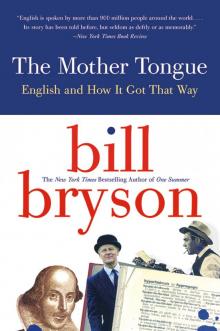 The Mother Tongue
The Mother Tongue Shakespeare
Shakespeare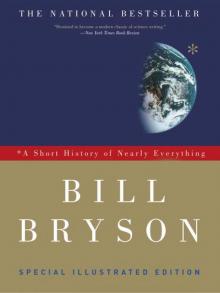 A Short History of Nearly Everything: Special Illustrated Edition
A Short History of Nearly Everything: Special Illustrated Edition The Best American Travel Writing 2016
The Best American Travel Writing 2016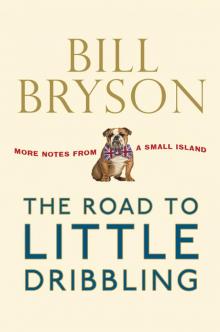 The Road to Little Dribbling
The Road to Little Dribbling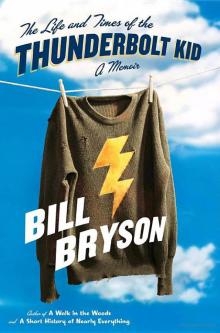 The Life And Times Of The Thunderbolt Kid: A Memoir (v5.0)
The Life And Times Of The Thunderbolt Kid: A Memoir (v5.0) Made In America
Made In America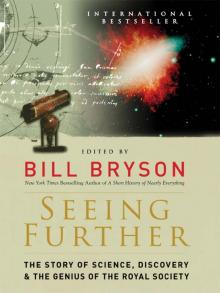 Seeing Further
Seeing Further Shakespeare: The World as Stage
Shakespeare: The World as Stage The Life and Times of the Thunderbolt Kid
The Life and Times of the Thunderbolt Kid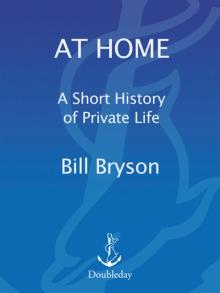 At Home
At Home Bryson's Dictionary For Writers And Editors (v5.0)
Bryson's Dictionary For Writers And Editors (v5.0) Neither Here Nor There
Neither Here Nor There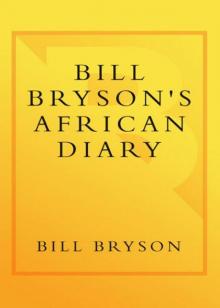 Bill Bryson's African Diary
Bill Bryson's African Diary